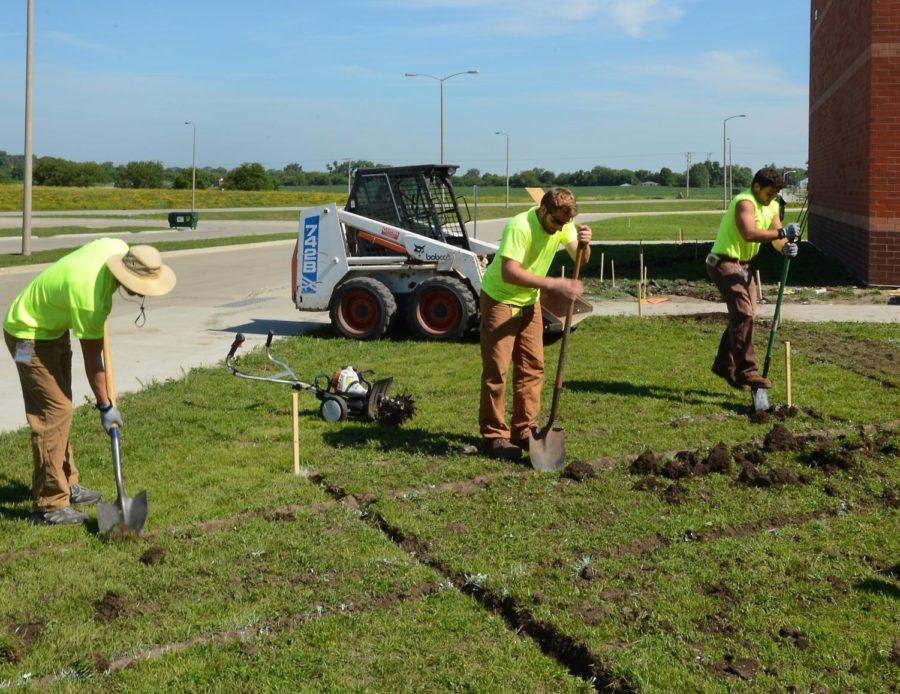ISU students plan, build prison employees’ relaxation patio
July 16, 2014
Landscape architecture students from Iowa State began building a decompression area for the officers at the Iowa Correctional Institution for Women this summer.
The eight students have been working on the restorative outdoor space, known as the decompression patio, after noticing that the prison employees had only the parking lot to go to for their breaks or the time after their shifts ended.
“If they go on breaks or get to work early, they usually just sit out in their cars and then go back in,” said Austin Javellana, senior in landscape architecture. “It really isn’t conducive to a break, especially in the summer when it’s hot.”
Prison employees’ days are long and stressful and they will often stand out in the prison parking lot to decompress from the day after their shifts and talk to other employees before going home, said Julie Stevens, assistant professor of landscape design and the leader of the project.
The students, working as paid interns, offered to build a space where the employees could relax and unwind. The group asked the officers for a wish list of what they would like to see in the decompression area.
The students then split into groups of two and worked together to make a design that would fit the officers’ wishes as well as follow the prison security rules. Then they shared their ideas with the prison so that they could pick and choose what they wanted before meeting and merging all of their ideas together.
“[The students’] process was rapid and remarkable,” Stevens said. “They all worked incredibly well together from my perspective. It’s like a dream team of students.”
The employee wish list included a magnolia tree, a fountain as a memorial of a former warden, grills, leaning walls and television screens.
“One thing officers were adamant about was not having anything or any luxuries that the women can’t have. If they were going to have this space, they wanted to make sure it wasn’t going to be flaunted in front of the women,” Stevens said. “We thought that was really great because they really do care. They stick to the rules, but they care.”
The students were not alone in their endeavors. A group of offenders were sent out to help them with the project.
“If you know how women talk, you know that there’s lots of chatter, there’s some gossiping and rumors move around pretty quickly,” Stevens said. “We’re pretty excited that we’ve introduced them to positive rumors, so when they say, ‘I’ve heard you’re planting 60 trees, is that a rumor?’, we can say, “No, that’s not a rumor. It’s actually true.’”
Helping with the projects around the prison’s campus gives the women a sense of ownership and home while in prison, Stevens said.
The women were quiet at first, but Javellana said they are starting to incorporate their own ideas into the project.
“It allows them to be part of the process, a part of what is going on around them.” Said Javellana.
Among one of the most difficult challenges Javellana said the team has faced in the project is the security guidelines and rules the students have to follow while working at the prison. The patio is about 70 feet away from the prison fence, and the students have to make sure their plans do not get any closer.
They also have to work around obstacles such as electrical wires and rain runoff. The group has to go through prison security everyday that they are on-site and they are not permitted to wear orange, the color of the women’s sweatshirts.
Later this year, the students will be asked to look at the men’s maximum prison facility in Fort Madison as well as the Iowa State Penitentiary.
“That will be a totally different situation because you have 300 to 350 life sentences there for crimes you can’t even imagine,” Stevens said. “But that’s not to say that these people are not still human, and even though we are frightened or upset by the things that they have done, they are there for life and they should be able to grow food and plant flowers and live life the best they can.”
The project at the Iowa Correctional Institution for Women is set to be complete by the end of July or early August.







